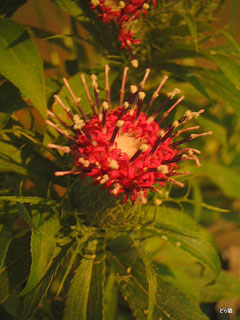 |
|
http://photozou.jp/photo/show/110033/26530920 |
 |
|
Translate this page:
Summary
Physical Characteristics

 Atractylodes macrocephala is a PERENNIAL growing to 0.5 m (1ft 8in) by 0.4 m (1ft 4in).
Atractylodes macrocephala is a PERENNIAL growing to 0.5 m (1ft 8in) by 0.4 m (1ft 4in).
See above for USDA hardiness. It is hardy to UK zone 6. It is in flower from July to August, and the seeds ripen from August to September. The species is dioecious (individual flowers are either male or female, but only one sex is to be found on any one plant so both male and female plants must be grown if seed is required). .
Suitable for: light (sandy), medium (loamy) and heavy (clay) soils and prefers well-drained soil. Suitable pH: mildly acid, neutral and basic (mildly alkaline) soils. It can grow in semi-shade (light woodland) or no shade. It prefers moist soil.
UK Hardiness Map
US Hardiness Map
Synonyms
Plant Habitats
Cultivated Beds;
Edible Uses
References More on Edible Uses
Medicinal Uses
Plants For A Future can not take any responsibility for any adverse effects from the use of plants. Always seek advice from a professional before using a plant medicinally.
Antibacterial Diuretic Sedative Stomachic Tonic
Bai Zhu is widely used in traditional Chinese medicine[238]. The root contains an essential oil, glucoside and inulin[283]. It is a bitter-sweet tonic herb that acts mainly upon the digestive system and strengthens the spleen[238, 254]. The root is antibacterial, diuretic, hypoglycaemic, sedative, stomachic and tonic[176, 238]. It is used in the treatment of poor appetite, dyspepsia, abdominal distension, chronic diarrhoea, oedema and spontaneous sweating[176]. It is often used in conjunction with other herbs such as Codonopsis tangshen and Glycyrrhiza uralensis[238]. Combined with Baical skullcap (Scutellaria baicalensis) it is used to prevent miscarriage[254]. The roots are harvested in the autumn and baked for use in tonics[238].
References More on Medicinal Uses
The Bookshop: Edible Plant Books
Our Latest books on Perennial Plants For Food Forests and Permaculture Gardens in paperback or digital formats.

Edible Tropical Plants
Food Forest Plants for Hotter Conditions: 250+ Plants For Tropical Food Forests & Permaculture Gardens.
More

Edible Temperate Plants
Plants for Your Food Forest: 500 Plants for Temperate Food Forests & Permaculture Gardens.
More

More Books
PFAF have eight books available in paperback and digital formats. Browse the shop for more information.
Shop Now
Other Uses
References More on Other Uses
Cultivation details
Succeeds in any well-drained soil in sun or partial shade[238]. This species is probably hardy in most of Britain, it tolerates temperatures down to at least -15°c[238]. Widely cultivated in China for its use as a medicinal herb[238, 266]. This species is dioecious. Both male and female plants need to be grown if seed is required[266].
References Carbon Farming Information and Carbon Sequestration Information
Temperature Converter
Type a value in the Celsius field to convert the value to Fahrenheit:
Fahrenheit:
The PFAF Bookshop
Plants For A Future have a number of books available in paperback and digital form. Book titles include Edible Plants, Edible Perennials, Edible Trees,Edible Shrubs, Woodland Gardening, and Temperate Food Forest Plants. Our new book is Food Forest Plants For Hotter Conditions (Tropical and Sub-Tropical).
Shop Now
Plant Propagation
Seed - sow spring in a cold frame and only just cover the seed. Prick out the seedlings when they are large enough to handle and plant them out into their permanent positions in the following spring or early summer.
Other Names
If available other names are mentioned here
Native Range
TEMPERATE ASIA: China (Anhui Sheng (west), Zhejiang Sheng, Fujian Sheng (north), Hunan Sheng, Hubei Sheng, Jiangxi Sheng (west), Guizhou Sheng)
Weed Potential
Right plant wrong place. We are currently updating this section.
Please note that a plant may be invasive in one area but may not in your area so it's worth checking.
Conservation Status
IUCN Red List of Threatened Plants Status :

Growth: S = slow M = medium F = fast. Soil: L = light (sandy) M = medium H = heavy (clay). pH: A = acid N = neutral B = basic (alkaline). Shade: F = full shade S = semi-shade N = no shade. Moisture: D = dry M = Moist We = wet Wa = water.
Now available:
Food Forest Plants for Mediterranean Conditions
350+ Perennial Plants For Mediterranean and Drier Food Forests and Permaculture Gardens.
[Paperback and eBook]
This is the third in Plants For A Future's series of plant guides for food forests tailored to
specific climate zones. Following volumes on temperate and tropical ecosystems, this book focuses
on species suited to Mediterranean conditions—regions with hot, dry summers and cool, wet winters,
often facing the added challenge of climate change.
Read More
Expert comment
Author
Koidz.
Botanical References
238266
Links / References
For a list of references used on this page please go here
Readers comment
© 2010, Plants For A Future. Plants For A Future is a charitable company limited by guarantee, registered in England and Wales. Charity No. 1057719, Company No. 3204567.